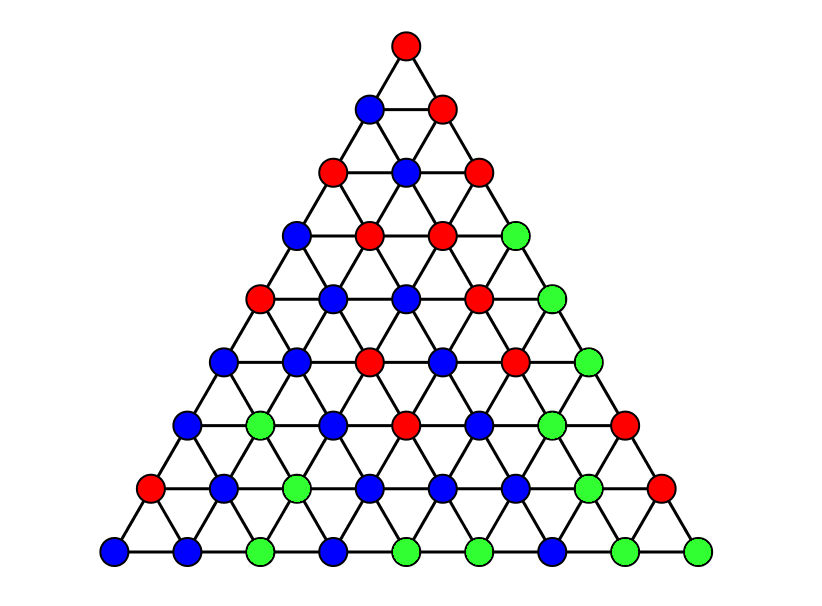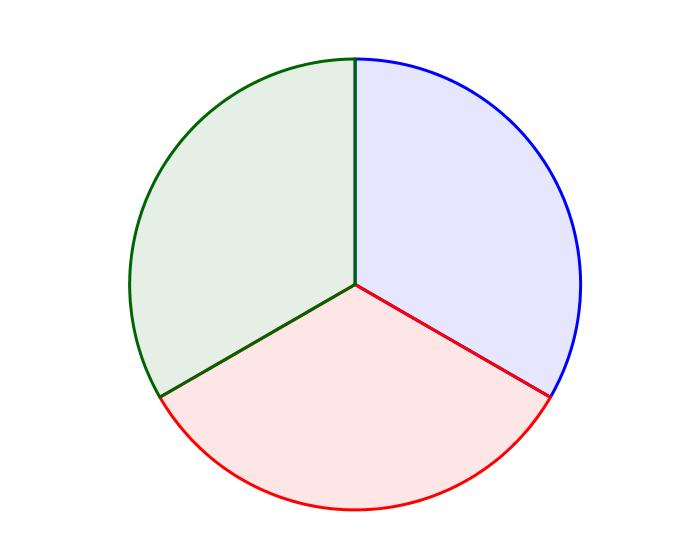This is one of three sets of fixed point exercises. The first post in this sequence is here, giving context.
1. (1-D Sperner's lemma) Consider a path built out of edges as shown. Color each vertex blue or green such that the leftmost vertex is blue and the rightmost vertex is green. Show that an odd number of the edges will be bichromatic.

2. (Intermediate value theorem) The Bolzano-Weierstrass theorem states that any bounded sequence in has a convergent subsequence. The intermediate value theorem states that if you have a continuous function such that and , then there exists an such that . Prove the intermediate value theorem. It may be helpful later on if your proof uses 1-D Sperner's lemma and the Bolzano-Weierstrass theorem
3. (1-D Brouwer fixed point theorem) Show that any continuous function has a fixed point (i.e. a point with ). Why is this not true for the open interval ?
4. (2-D Sperner's lemma) Consider a triangle built out of smaller triangles as shown. Color each vertex red, blue, or green, such that none of the vertices on the large bottom edge are red, none of the vertices on the large left edge are green, and none of the vertices on the large right edge are blue. Show that an odd number of the small triangles will be trichromatic.

5. Color the all the points in the disk as shown. Let be a continuous function from a closed triangle to the disk, such that the bottom edge is sent to non-red points, the left edge is sent to non-green points, and the right edge is sent to non-blue points. Show that sends some point in the triangle to the center.

6. Show that any continuous function from closed triangle to itself has a fixed point.
7. (2-D Brouwer fixed point theorem) Show that any continuous function from a compact convex subset of to itself has a fixed point. (You may use the fact that given any closed convex subset of , the function from to which projects each point to the nearest point in is well defined and continuous.)
8. Reflect on how non-constructive all of the above fixed-point findings are. Find a parameterized class of functions where for each , , and the function is continuous, but there is no continuous way to pick out a single fixed point from each function (i.e. no continuous function such that is a fixed point of for all ).
9. (Sperner's lemma) Generalize exercises 1 and 4 to an arbitrary dimension simplex.
10. (Brouwer fixed point theorem) Show that any continuous function from a compact convex subset of to itself has a fixed point.
11. Given two nonempty compact subsets , the Hausdorff distance between them is the supremum
over all points in either subset of the distance from that point to the other subset. We call a set valued function a continuous Hausdorff limit if there is a sequence of continuous functions from to whose graphs, , converge to the graph of , , in Hausdorff distance. Show that every continuous Hausdorff limit from a compact convex subset of to itself has a fixed point (a point such that ).
12. Let and be nonempty compact convex subsets of . We say that a set valued function, is a Kakutani function if the graph of , , is closed, and is convex and nonempty for all . For example, we could take and to be the interval , and we could have send each to , map to the whole interval , and map to . Show that every Kakutani function is a continuous Hausdorff limit. (Hint: Start with the case where is a unit cube. Construct by breaking into small cubes of side length . Constuct a smaller cube of side length within each cube. Send each small to the convex hull of the images of all points in the cube with a continuous function, and glue these together with straight lines. Make sure you don't accidentally get extra limit points.)
13. (Kakutani fixed point theorem) Show that every Kakutani function from a compact convex subset of to itself has a fixed point.
Please use the spoilers feature - the symbol '>' followed by '!' followed by space -in your comments to hide all solutions, partial solutions, and other discussions of the math. The comments will be moderated strictly to hide spoilers!
I recommend putting all the object level points in spoilers and leaving metadata outside of the spoilers, like so: "I think I've solved problem #5, here's my solution <spoilers>" or "I'd like help with problem #3, here's what I understand <spoilers>" so that people can choose what to read.
Found a nice proof for Sperner's lemma (#9):
First some definitions. Call a d-simplex with vertices colored in (d+1) different colored chromatic. Call the parity of the number of chromatic simplices the chromatic parity.
It's easier to prove the following generalization: Take a complex of d-simplices that form a d-sphere: then any (d+1)-coloring of the vertices will have even chromatic parity.
Proof by induction on d:
Base d=-1: vacuously true.
Assume true for d-1: Say you have an arbitrary complex of d-simplices forming a d-sphere, with an arbitrary d+1-coloring. Choose a vertex. W.L.O.G. we will call the color of the chosen vertex blue.
Take the complex of simplices that contain this vertex. Since a sphere has no boundary or branches, this complex will be a d-ball. Delete the chosen vertex, and keep only the opposite (d-1)-simplices that are left, which will form a (d-1)-sphere, call it the shell.
We need to choose a second color, say red. We'll call a (d-1)-simplex with vertices of all d+1 colors except red an R-chromatic face, and similarly with blue.
Now, replace all the red vertices in the shell with blue vertices, so that the shell is now R-chromatic. By induction it has an even number of R-chromatic faces. Consider what happens when we reconvert a vertex on the shell back to red: since the vertex was previously blue, any R-chromatic faces will get turned into B-chromatic faces. Let r be the number of R-chromatic faces on the shell, and b be the number of B-chromatic faces. The parity of r-b will remain even as we continue this process.
Let's go back to the vertex in the center of the shell. All currently chromatic simplices with this vertex have opposite faces which are B-chromatic, since this vertex is blue. We'll flip the vertex to red, which destroys chromatic simplices with opposite B-chromatic faces and creates chromatic simplices with opposite R-chromatic faces. Since r-b is even, the chromatic parity is preserved!
Since we've shown that arbitrary recoloring of vertices preserves the chromatic parity, it's clear that the chromatic parity will be even for any coloring.
Corollary: Sperner's lemma
Start with a d-simplex which has been divided into d-simplices, and where each face of the large simplex has one color which vertices on it are forbidden from taking. Take a point of each color, and match it with a face of the simplex that that color is allowed on. Then connect that vertex to each point on that face. This will create a bunch of non-chromatic simplices. Finally, create a simplex of all of the new points. This will create one chromatic simplex.
This will form a d-sphere, and thus will have an even chromatic parity. That means the original simplex must have had odd chromatic parity.
Awesome! I was hoping that there would be a way to do this!